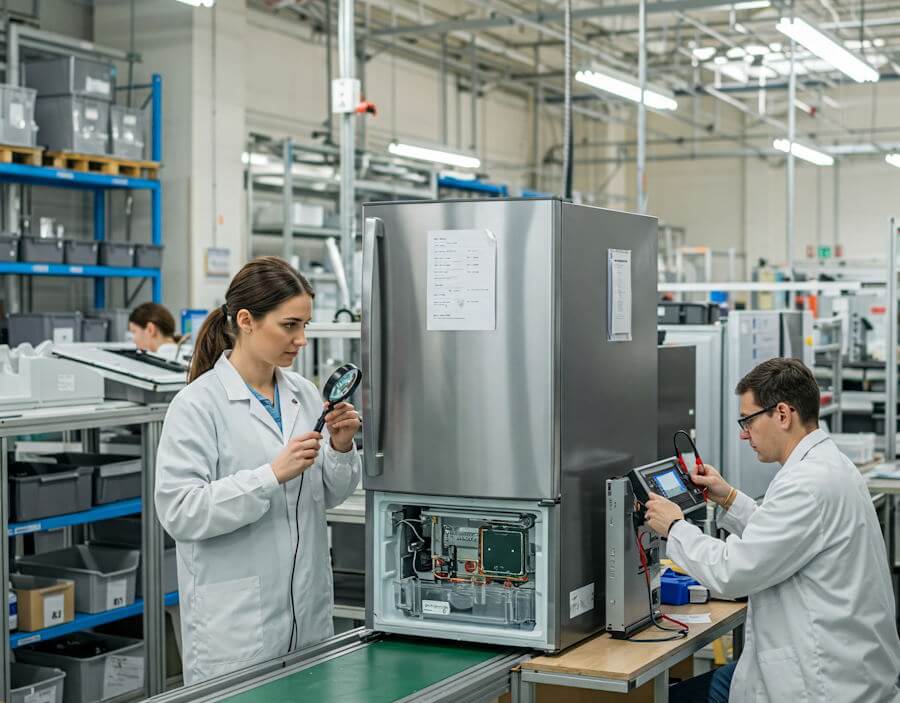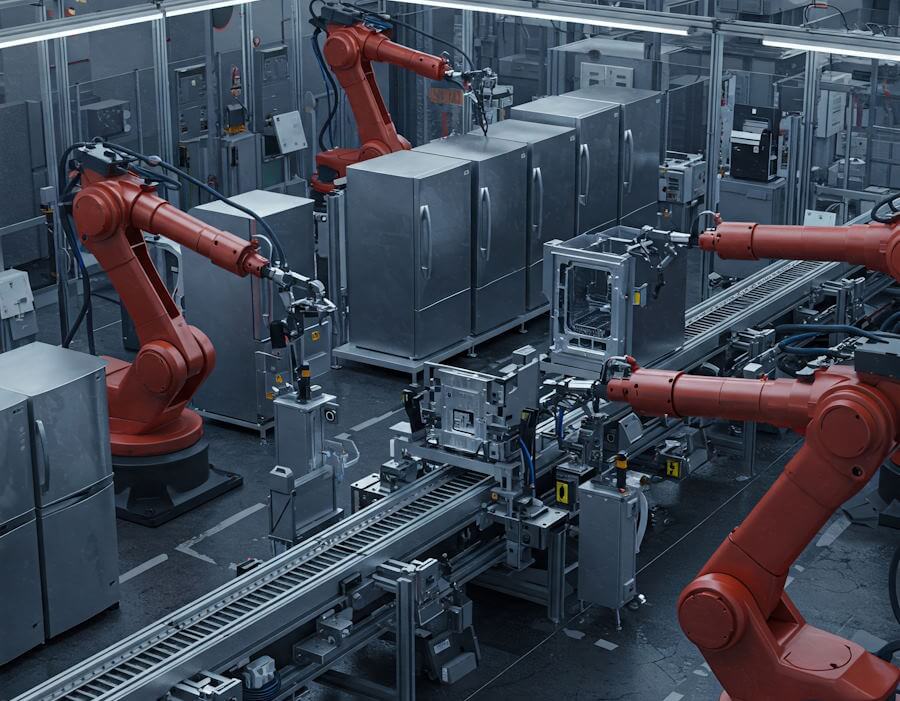Introduction to Quality Control in Home Appliances
Quality control (QC) in the home appliance industry is a critical component that ensures products meet specific standards and perform safely and effectively. It encompasses a systematic approach to overseeing the various stages of production, from design and manufacturing to post-sale evaluation. The primary purpose of quality control is to maintain high manufacturing standards, reduce defects, and enhance consumer satisfaction. As home appliances evolve, the significance of quality control processes has only intensified.
At its core, quality control involves numerous processes designed to monitor and improve product quality. These processes often include quality planning, quality assurance, and quality improvement. Quality planning involves establishing quality objectives and requirements, which serve as benchmarks for manufacturing. Quality assurance focuses on preventing defects through proactive measures such as training, process documentation, and performance evaluations. Lastly, quality improvement utilizes data collected from previous production runs to identify problem areas and implement corrective actions.
The impact of quality control extends beyond production; it affects consumer satisfaction and brand reputation significantly. High-quality home appliances contribute to enhanced user experience, leading to increased trust and loyalty among consumers. In contrast, poor-quality products can result in consumer complaints and brand damage, which can take a long time to recover from. As a result, manufacturers are compelled to adopt stringent quality control measures to remain competitive in the rapidly evolving home appliance market.
The evolution of quality control practices in the home appliance industry has progressed from basic inspection methods to more sophisticated statistical quality control techniques. The implementation of technology, such as automated quality checks and real-time data analysis, has further improved the efficacy of quality control. This evolution marks a shift towards a more integrated approach to quality assurance, emphasizing continuous improvement and customer feedback.
The Importance of Quality Control Standards
In the home appliance industry, quality control standards play a critical role in ensuring that products meet safety and performance expectations. Major quality control standards such as ISO 9001, CE marking, and UL certification have become benchmarks for manufacturers aiming for excellence in their offerings. These standards not only enhance product reliability but also instill trust among consumers, which is vital in a competitive market.
The ISO 9001 standard is one of the most recognized quality management system standards globally. It provides a framework that organizations can follow to improve their processes, enhance customer satisfaction, and ensure consistency in the quality of their appliances. By adhering to ISO 9001, companies within the home appliance sector demonstrate their commitment to quality improvement and operational efficiency, which ultimately translates into better products for consumers.
CE marking is particularly significant within the European market. It indicates that a product conforms to essential health, safety, and environmental protection standards. For home appliance manufacturers, obtaining CE marking is mandatory for selling products in the European Economic Area (EEA). This certification not only ensures that products are safe for use but also prevents substandard items from entering the market. Compliance with CE marking requirements fosters consumer confidence and can ultimately lead to increased sales.
UL certification, primarily recognized in North America, serves a complementary purpose, focusing on product safety. UL (Underwriters Laboratories) rigorously tests appliances to verify that they meet specific operational and safety guidelines. Products bearing the UL mark reassure consumers that the appliances they are purchasing have undergone thorough safety evaluation and are designed to perform as expected. With stringent adherence to these quality control standards, manufacturers set themselves apart in the home appliance industry, emphasizing reliability and safety as key attributes of their products.
Quality Control Processes in Home Appliance Manufacturing
Quality control in the home appliance manufacturing sector is essential for ensuring that products not only meet customer expectations but also comply with industry standards. Several methodologies underpin these quality control processes, namely Total Quality Management (TQM), Six Sigma, and Statistical Process Control (SPC). Each of these methodologies offers distinct advantages that contribute to enhanced product quality and operational efficiency.
Total Quality Management (TQM) focuses on continuous improvement and the involvement of all employees in the quality improvement process. TQM encourages a culture where quality is the responsibility of every team member, fostering collaboration and commitment to excellence. By integrating TQM principles, manufacturers of home appliances can streamline their operations, minimize defects, and ultimately enhance customer satisfaction. The cyclical nature of TQM emphasizes ongoing feedback and refinement, ensuring that quality remains a core focus throughout the manufacturing process.
Another critical methodology is Six Sigma, which utilizes a data-driven approach to eliminate defects and reduce variability in manufacturing processes. By adhering to Six Sigma principles, companies can achieve significant increases in quality and efficiency. This methodology employs tools such as DMAIC (Define, Measure, Analyze, Improve, Control), allowing manufacturers to systematically identify issues, analyze their root causes, and implement sustainable solutions. The results often manifest as lower production costs, improved product reliability, and enhanced customer loyalty.
Statistical Process Control (SPC) serves as an essential technique within quality management, utilizing statistical methods to monitor and control manufacturing processes. Through real-time analysis, SPC enables manufacturers to detect deviations from established standards promptly. This proactive approach minimizes the risk of defects reaching the consumer, thereby safeguarding the brand’s reputation in a competitive market. By embedding these quality control processes into their manufacturing frameworks, home appliance producers can ensure a consistent level of quality, meeting the demands of today’s discerning consumers.
Impact of Quality Control on Consumer Trust and Brand Loyalty
In the competitive landscape of the home appliance industry, quality control plays a pivotal role in shaping consumer trust and brand loyalty. When manufacturers adhere to stringent quality control measures, the result is a more consistent and reliable product, fostering a sense of trust among consumers. Statistical data suggests that nearly 70% of consumers are willing to pay a premium for appliances known for their superior quality. This willingness is often underpinned by positive past experiences, which can be directly attributed to effective quality management practices.
For instance, a prominent study conducted by the Appliance Research Group revealed that brands showcasing a commitment to quality control saw a 40% higher customer retention rate compared to those with inconsistent product offerings. This significant increase in brand loyalty indicates that consumers are likely to stick to trusted brands that consistently deliver high-quality products. Moreover, when appliances fail to meet expected standards, it not only tarnishes the brand’s reputation but also diminishes consumer confidence in the overall market.
Consider the example of a well-known home appliance manufacturer that implemented rigorous quality checks throughout its production process. Following the introduction of these measures, the company reported a 30% reduction in product returns due to defects. Consequently, this improvement not only enhanced the brand’s standing in the consumer perception market but also strengthened customer loyalty as feedback demonstrated increased satisfaction rates among its users. Such cases highlight the essential role quality control plays in influencing consumer behavior and perceptions.
Overall, quality control directly affects a brand’s ability to foster trust and loyalty amongst consumers. When a company invests in maintaining high standards of quality, it enhances its reputation, ultimately leading to greater consumer engagement and brand advocacy.
Challenges in Implementing Quality Control
The home appliance industry faces a myriad of challenges when it comes to implementing effective quality control measures. One prominent issue is budget limitations. Many manufacturers struggle to allocate sufficient financial resources toward quality control initiatives, which can lead to compromised standards. This financial constraint often means that companies are unable to invest in advanced testing equipment or quality assurance programs, ultimately affecting the durability and performance of their products.
Another significant challenge is workforce training. The complexity of home appliances necessitates a highly skilled workforce capable of understanding and adhering to rigorous quality standards. However, manufacturers often find it challenging to train their staff adequately. Employees may not fully grasp the importance of quality control practices, leading to inconsistent adherence to procedures. It is crucial for companies to develop comprehensive training programs that emphasize the role of quality control in enhancing product reliability and customer satisfaction.
Technology integration also presents a hurdle for manufacturers looking to streamline their quality control processes. While contemporary technologies offer innovative solutions, the adoption process can be daunting due to the unfamiliarity with new systems among existing staff and potential disruptions to production schedules. Effective integration of technology demands not only a financial investment but also a commitment to ongoing education in new best practices in quality management.
Lastly, managing supply chain variability can pose significant risks to maintaining quality standards. Fluctuations in raw material availability or changes in supplier reliability can compromise product consistency. To mitigate these supply chain challenges, manufacturers should develop strong relationships with suppliers and implement stringent quality assessments on incoming materials. By embracing these strategies, companies can enhance their overall quality control efforts, ultimately leading to better home appliance products for consumers.
Technological Advances in Quality Control
The home appliance industry has undergone significant transformations, largely due to technological advancements in quality control processes. Automation, artificial intelligence (AI), and machine learning (ML) have emerged as vital tools that enhance the scrutiny and reliability of the manufacturing chain. The integration of these technologies allows manufacturers to streamline inspections, refine data analytics, and ultimately elevate overall product quality.
Automation plays a crucial role by enabling the consistent application of quality control measures throughout the production process. Automated systems can quickly identify defects and inconsistencies that might elude human inspectors. For instance, computerized vision systems equipped with advanced imaging technology can detect surface flaws or misalignments that could affect functionality and consumer safety. This level of precision not only enhances quality assurance but also increases operational efficiency, as fewer resources are expended on error corrections later in the production phase.
Artificial intelligence further refines quality control processes. Machine learning algorithms analyze vast datasets generated during manufacturing, allowing for predictive maintenance and real-time quality monitoring. These systems are capable of recognizing patterns and anomalies that hint at potential defects, thus enabling proactive measures before products reach the market. The result is a noticeable reduction in recall incidents and warranty claims, fostering greater consumer trust in brand quality.
Moreover, data analytics driven by these technologies empowers manufacturers to make informed decisions. By translating quality metrics into actionable insights, companies can continuously improve their processes and product designs. This data-centric approach not only enhances customer satisfaction through defect-free products but also provides companies with a competitive edge in a saturated market where reliability is paramount. As technological innovations continue to evolve, their implications for quality control in the home appliance industry are becoming increasingly profound, shaping a future of enhanced product excellence.
Quality Control in Environmental Sustainability
Quality control plays a significant role in promoting environmental sustainability within the home appliance industry. As manufacturers look to minimize their ecological footprint, robust quality control systems ensure that products are not only functional but also align with sustainability initiatives. By embedding quality control measures, companies can effectively reduce waste throughout the production process. This includes minimizing defective products that end up in landfills, as rigorous testing and evaluation help in identifying issues before appliances reach the consumer market.
In addition to reducing waste, quality control contributes to improving energy efficiency in home appliances. Products that are designed and manufactured under strict quality standards are more likely to perform optimally, which leads to lower energy consumption. For instance, energy-efficient washing machines and refrigerators undergo exhaustive testing to ensure that they operate within defined energy usage parameters. Through quality control, manufacturers can identify and rectify inefficiencies during the design phase, ensuring that the final products not only meet but exceed energy efficiency benchmarks.
Moreover, the selection of eco-friendly materials is a crucial aspect of sustainable practices. Quality control processes encourage manufacturers to source and utilize materials that are not only durable but also environmentally friendly. This means selecting biodegradable or recyclable components, which contribute to a product’s overall lifecycle sustainability. Ensuring that these materials meet quality standards before they enter the production line can further enhance the eco-friendliness of finished appliances.
Ultimately, integrating quality control into the production of home appliances means aligning with broader environmental goals. By doing so, manufacturers not only comply with regulations but also enhance their reputations among consumers who are increasingly seeking sustainable products. This intersection of quality control and environmental sustainability is vital for fostering an industry that is both responsible and innovative.
Future Trends in Quality Control for Home Appliances
As the home appliance industry evolves, the future of quality control is poised for significant transformation, driven largely by advancements in technology and shifting consumer expectations. One of the most notable trends is the increasing reliance on consumer feedback. With the emergence of social media platforms and online review sites, manufacturers are now more attuned to the opinions and experiences of their customers. This real-time feedback not only helps to identify potential quality issues but also aids in enhancing product design and functionality. Incorporating consumer insights into quality control processes ensures that products meet the dynamic needs of the market.
Another trend is the integration of smart technology, which allows for real-time quality monitoring of appliances. IoT-enabled devices can collect data on product performance and user interaction, providing manufacturers with critical insight into potential defects or areas for improvement. This proactive approach to quality management not only enhances overall product reliability but also fosters a culture of continuous improvement within organizations. Manufacturers are increasingly investing in advanced analytics tools to better predict failures and optimize their quality control strategies.
Furthermore, there is a notable shift toward personalized quality standards as consumer preferences grow more sophisticated. In today’s competitive landscape, one-size-fits-all approaches are no longer viable. Manufacturers are recognizing the need to segment their quality control processes to align with varied consumer demographics and preferences. This involves tailoring quality assurance protocols to match specific market segments, ensuring that all appliances adhere to the unique demands and expectations of their target audiences. As a result, personalization in quality control not only enhances customer satisfaction but also promotes brand loyalty.
Conclusion: The Role of Quality Control in Shaping the Future of Home Appliances
In the contemporary landscape of the home appliance industry, quality control emerges as a pivotal element influencing both current practices and future advancements. The comprehensive examination of this domain reveals that rigorous quality management systems not only ensure the production of reliable and efficient appliances but also foster consumer trust and brand loyalty. As the market continues to evolve with emerging technologies and shifting consumer preferences, the importance of quality control becomes increasingly pronounced.
One of the primary roles of quality control is to safeguard the health, safety, and satisfaction of consumers who rely on home appliances daily. Through meticulous testing and adherence to safety regulations, manufacturers can mitigate risks associated with faulty products, thereby enhancing overall consumer well-being. This dedication to quality not only prevents costly recalls and reputational damage but also strengthens the industry’s integrity as a whole.
Furthermore, as sustainability becomes a critical focal point in the home appliance sector, quality control is essential in ensuring that appliances are not just efficient but also environmentally friendly. By integrating quality assurance practices that prioritize energy efficiency and sustainability, manufacturers can respond to the growing consumer demand for responsible products. This alignment with evolving market expectations not only drives competitiveness but also contributes to the industry’s adaptability in the face of regulatory changes and technological advancements.
In conclusion, the strategic emphasis on quality control is indispensable for navigating the challenges and opportunities that lie ahead in the home appliance industry. As companies continue to innovate and improve, the ongoing commitment to rigorous quality practices will undoubtedly determine their success and relevance in an ever-changing market landscape. By fostering a culture of quality, the home appliance industry can not only meet contemporary consumer expectations but also pave the way for a sustainable and prosperous future.



